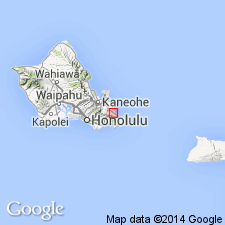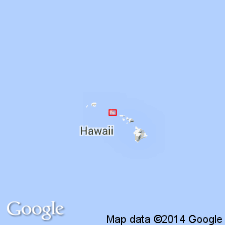
- Usage in publication:
-
- Kahuku Point Formation
- Modifications:
-
- Named
- Dominant lithology:
-
- Marl
- Limestone
- AAPG geologic province:
-
- Oahu
Summary:
Named for Kahuku Point Quarry, type locality of Kahuku (55-ft) stand of sea, Island of Oahu (Stearns, IN Stearns and Vaksvik, 1935, p.1933). [no type designated] Consists of basal marl unit (80 ft of largely light- to dark-gray, compact, fossiliferous, calcareous clay), an overlying reef and associated limestone (20 to 40 ft of light-gray silty limestone grading to cream to white, fine- to coarse-grained limestone), and an upper basaltic beachrock (24 to 34 ft thick). Unconformably overlies unnamed conglomerate. Unconformably underlies Kaena Point Formation (new). Tentatively assigned to Aftonian interglacial stage and Kansan glacial stage.
Source: GNU records (USGS DDS-6; Menlo GNULEX).

- Usage in publication:
-
- Kahuku Point Formation
- Modifications:
-
- Areal extent
- AAPG geologic province:
-
- Oahu
Summary:
Occurs in PCA and Kaiser Cement Company quarries where unit underlies firmly cemented calcareous beach sandstone of the PCA stand of sea in Lualualei valley, Island of Oahu.
Source: GNU records (USGS DDS-6; Menlo GNULEX).
For more information, please contact Nancy Stamm, Geologic Names Committee Secretary.
Asterisk (*) indicates published by U.S. Geological Survey authors.
"No current usage" (†) implies that a name has been abandoned or has fallen into disuse. Former usage and, if known, replacement name given in parentheses ( ).
Slash (/) indicates name conflicts with nomenclatural guidelines (CSN, 1933; ACSN, 1961, 1970; NACSN, 1983, 2005, 2021). May be explained within brackets ([ ]).

